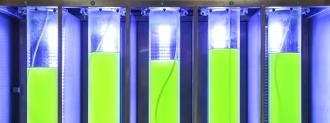Biofuels hold the promise of renewable, clean energy. If widely employed, they could reduce carbon dioxide emissions. But biofuels are costly because production is challenging. Currently, it is impossible to compete with oil and gas, even with government subsidies.
But researchers at Ohio State University have found a chemical reaction that may be a solution.
To make biofuels more cheaply, the team, led by biochemist Venkat Gopalan, focused on finding an easier way to produce a chemical reaction at the core of many biological processes.
The Role of “Helper Molecules”
The chemical reaction they needed creates “helper molecules,” essential components of bioenergy production. These molecules, which scientists call cofactors, allow carbon in plant cells to turn into energy. They play a crucial role in turning sugar from plants into butanol or ethanol for fuel.
These cofactors are called NADH and NADPH (nicotinamide adenine dinucleotide and hydrogen or phosphate, respectively)
But NADH and NADPH are expensive to make.
“The process of converting sugar to alcohol has to be very efficient if you want to have the end product be competitive with fossil fuels,” said Gopalan, an author on the paper. “This new development is likely to help lower the cost.”
A New Chemical Reaction Creates Cofactors in the Lab
To create the cofactors, the team built an electrode with two inexpensive elements: nickel and copper. The electrode can recreate the cofactors from their oxidized forms — a cheaper, simpler way to create these critical helper molecules than the old-fashioned way.
Next, they did a test to show that their electrode-created NADH can successfully produce alcohol from another molecule. They published their work in the journal Scientific Reports.
Scientists have been trying to lower the cost of biofuel production for some time, with little success. The new precursor chemical reaction promises to cut production costs, so the team anticipates it will ultimately also lower the cost of biofuels overall.
Possible Bonus Factors
There are other implications to this work. In addition to turning plants into fuel, these cofactors also play a role in slowing cancer’s metabolism and are used in some cancer treatments.
Although more far-fetched, another potential use is in creating synthetic plants that could reduce carbon dioxide in the atmosphere — an idea Vish Subramaniam, an author on the paper, previously explored.
I’ve always been interested in that question of, ‘Can we make a synthetic plant? Can we make something that can solve this global warming problem with carbon dioxide?’
Vish Subramaniam
NADPH also helps plants convert carbon dioxide to sugar, which photosynthesis converts to oxygen. Cheap NADPH could one day aid in artificially boosted photosynthesis, assisting synthetic plants in drawing excess CO2 out of the atmosphere, stripping out the carbon, and releasing the oxygen.
“I’ve always been interested in that question of, ‘Can we make a synthetic plant? Can we make something that can solve this global warming problem with carbon dioxide?'” Subramaniam said.
“If it’s impractical to do it with plants because we keep destroying them via deforestation, are there other inorganic ways of doing this?”
We’d love to hear from you! If you have a comment about this article or if you have a tip for a future Freethink story, please email us at [email protected].






